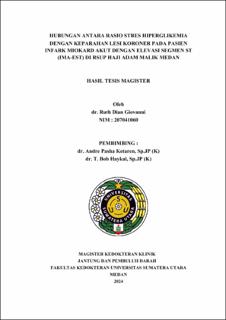Hubungan antara Rasio Stres Hiperglikemia dengan Keparahan Lesi Koroner pada Pasien Infark Miokard Akut dengan Elevasi Segmen ST (IMA-EST) di RSUP Haji Adam Malik Medan
Correlation Between Stress Hyperglycemia Ratio and Severity of Coronary Artery Lesion in Patients with ST-Elevation Myocardial Infarction in RSUP Haji Adam Malik Medan

Date
2024Author
Giovanni, Ruth Dian
Advisor(s)
Ketaren, Andre Pasha
Haykal, Teuku Bob
Metadata
Show full item recordAbstract
Background: Acute coronary syndrome occurs due to rupture or erosion of atherosclerotic plaques. Stress hyperglycemia is a condition of transient hyperglycemia in response to an acute condition of disease or stress. Hyperglycemia in myocardial infarction can be caused by increased catecholamine release, steroids, glucagon, and decreased insulin release. The usage of admission blood glucose is limited because it can reflect acute physiological stress and chronic glycemic levels. Stress hyperglycemia ratio is an index used to represent relative hyperglycemia using the ratio of admission blood glucose to an estimated chronic blood glucose. The purpose of this study was to determine the relationship between stress hyperglycemia ratio and the severity of coronary lesions in patients with acute myocardial infarction with ST segment elevation at H. Adam Malik Hospital Medan.
Methods: This study was conducted with cross sectional method on 240 patients with acute myocardial infarction with ST segment elevation at H. Adam Malik Hospital Medan who underwent coronary angiography from May 2022 to June 2024. The criteria for acute myocardial infarction with ST segment elevation follows the universal definition of myocardial infarction and the severity of coronary lesions is calculated based on the SYNTAX score. The data were analyzed univariably and bivariate to assess the relationship between the stress hyperglycemia ratio and the SYNTAX score, with p < 0.05 is considered statistically significant.
Results: The total number of study subjects was 240 people with an average age of 55.87 ± 9.846 years. Most of the subjects were male as many as 195 people (81.25%). The average stress hyperglycemia ratio was 1.13 and the average SYNTAX score was 21.5. There was a significant relationship between stress hyperglycemia ratio and severity of coronary lesions based on the SYNTAX score (p < 0.001). A significant relationship was also found between stress hyperglycemia ratio to the severity of coronary lesions based on SYNTAX scores in DM and non-DM populations (p < 0.001).
Conclusion: There is a significant relationship between stress hyperglycemia ratio and severity of coronary lesions in patients with acute myocardial infarction with ST segment elevation at H. Adam Malik Hospital, Medan.
